Tapichalaca Area
Wednesday, July 23, 2008: After breakfast, we drove up to the trailhead for the hike to the area where the antpittas can be seen. Feeding time is 8am, and we need to be there by then.
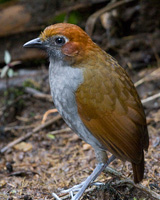 |
| Chestnut-naped Antpitta |
|---|
The walk up was rather frustrating. There were birds about, but a combination of rain and absolutely horrible light (everything silhouetted against clouds) made it virtually impossible for me to ID any birds. David and Paul could still identify a few of them, so I know some lifers were missed (e.g., White-capped Tanager), which only added to the frustration. Once we left the old road for the foot trail, the rain was more regular, so we hiked under umbrellas.
The Antpitta Experience
We got to the antpitta site in plenty of time. It's a roof with some places to sit and waited for the caretaker to show up. When he did, he started calling the antpittas by name! Panchito! Bibi! Yes, they've named each of them. He also started distributing mealy worms. Pretty soon, the antpittas started to approach. At first, they did not come out, then didn't stay out, but finally we were able to watch them almost continuously. Although we mostly saw the Jocotoco Antpitta, it is not the only antpitta here. The Chestnut-naped Antpittas also came for a few worms.
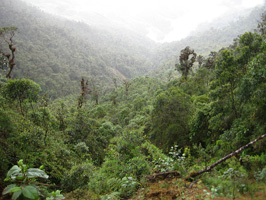 |
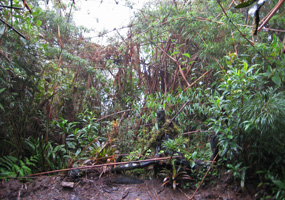 |
| Tapichalaca Reserve | Jocotoco Viewing Site |
|---|---|
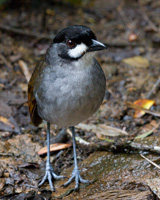 |
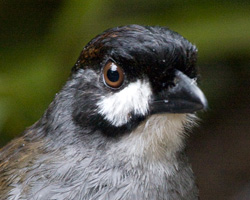 |
| Jocotoco Antpitta | Jocotoco Close-up |
The Jocotocos' behavior is rather amusing at times. They zip out onto the trail, then freeze in an upright position, so they can get a good view of the surroundings. Then they'll make a quick movement, and freeze again. It's almost like they are telling you that there's nothing to see here, nothing that moved. We could watch them some in the woods. They're a bit more relaxed when under cover.
The antpittas are raising young, and we could see them going back in the woods to feed them. We could sort of see one being fed, but couldn't actually see the youngster. One of the other birds was clearly only a year old, as could be told by the rufous tones in the crown. It's good to see they are successfully breeding as the Tapichalaca Reserve is the only reliable place to see them, and perhaps the only breeding location.
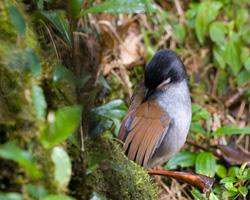 |
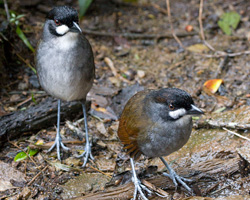 |
| Jocotoco Preening | Jocotoco Antpittas |
|---|---|
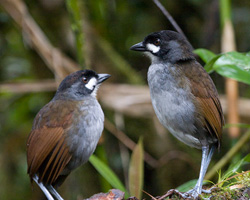 |
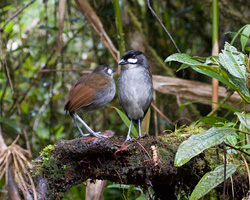 |
| Jocotoco times two | |
Back at the Lodge
Birding on our return to the lodge was no more exciting than on the way out. We stayed around the lodge for a while, checking the feedings and flora for other birds. This worked a lot better, and I was able to add White-sided Flower-piercer, Long-tailed Sylph, Buff-winged Starfrontlet, and Pale-naped Brush-Finch to my life list. We also saw a number of other birds, some of them lifers only yesterday.
We headed out again on the road in the reserve, this time finding some birds. The weather conditions were still a problem, but I was able to add Orange-banded Flycatcher, Black-crested Warbler, Fawn-breasted Brilliant, Silver-backed (Silvery) Tanager, Saffron-crowned Tanager, and Montane Woodcreeper to my life list.
To Valladolid, and South!
We then headed south into some drier areas, going though Valladolid toward the Peruvian border. This area of southern Zamora-Chinchipe province is in the Rio Marañon drainage. Because of that, we could find some birds that would not be possible elsewhere in Ecuador. New birds included Flame-faced Tanager, White-tailed Tyrannulet, Brown-capped Vireo, Blue-winged Mountain-Tanager, Metallic-green Tanager, Cinnamon Flycatcher, Beryl-spangled Tanager, Streak-necked Flycatcher, Rufous-tailed Tyrant, Maranon Thrush*, Streaked Saltator, Little Ground-Tyrant*, and Black-faced Tanager*. The stars denote southern specialties, and the Little Ground-Tyrant was a true rarity! I gather the Maranon Thrush was also a bit out of its normal range (but only a bit).
In spite of the weather, today's totals were 59 species including 25 lifers, making a grand total of 363 bird species with 256 lifers.
Jocotoco Lodge, Tapichalaca Reserve